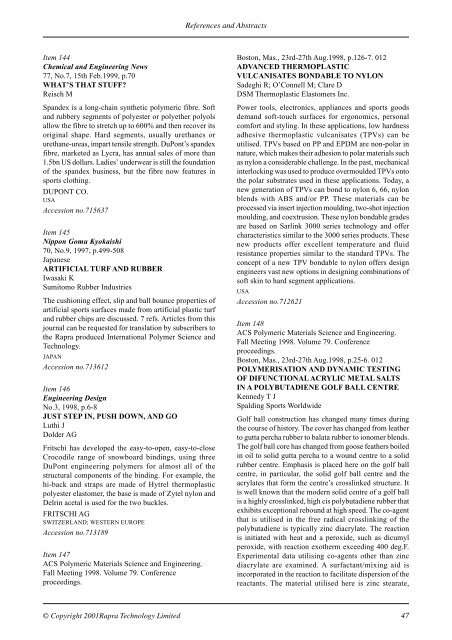Polymers in Sport and Leisure
Polymers in Sport and Leisure
Polymers in Sport and Leisure
Create successful ePaper yourself
Turn your PDF publications into a flip-book with our unique Google optimized e-Paper software.
References <strong>and</strong> Abstracts<br />
Item 144<br />
Chemical <strong>and</strong> Eng<strong>in</strong>eer<strong>in</strong>g News<br />
77, No.7, 15th Feb.1999, p.70<br />
WHAT’S THAT STUFF?<br />
Reisch M<br />
Sp<strong>and</strong>ex is a long-cha<strong>in</strong> synthetic polymeric fibre. Soft<br />
<strong>and</strong> rubbery segments of polyester or polyether polyols<br />
allow the fibre to stretch up to 600% <strong>and</strong> then recover its<br />
orig<strong>in</strong>al shape. Hard segments, usually urethanes or<br />
urethane-ureas, impart tensile strength. DuPont’s sp<strong>and</strong>ex<br />
fibre, marketed as Lycra, has annual sales of more than<br />
1.5bn US dollars. Ladies’ underwear is still the foundation<br />
of the sp<strong>and</strong>ex bus<strong>in</strong>ess, but the fibre now features <strong>in</strong><br />
sports cloth<strong>in</strong>g.<br />
DUPONT CO.<br />
USA<br />
Accession no.715637<br />
Item 145<br />
Nippon Gomu Kyokaishi<br />
70, No.9, 1997, p.499-508<br />
Japanese<br />
ARTIFICIAL TURF AND RUBBER<br />
Iwasaki K<br />
Sumitomo Rubber Industries<br />
The cushion<strong>in</strong>g effect, slip <strong>and</strong> ball bounce properties of<br />
artificial sports surfaces made from artificial plastic turf<br />
<strong>and</strong> rubber chips are discussed. 7 refs. Articles from this<br />
journal can be requested for translation by subscribers to<br />
the Rapra produced International Polymer Science <strong>and</strong><br />
Technology.<br />
JAPAN<br />
Accession no.713612<br />
Item 146<br />
Eng<strong>in</strong>eer<strong>in</strong>g Design<br />
No.3, 1998, p.6-8<br />
JUST STEP IN, PUSH DOWN, AND GO<br />
Luthi J<br />
Dolder AG<br />
Fritschi has developed the easy-to-open, easy-to-close<br />
Crocodile range of snowboard b<strong>in</strong>d<strong>in</strong>gs, us<strong>in</strong>g three<br />
DuPont eng<strong>in</strong>eer<strong>in</strong>g polymers for almost all of the<br />
structural components of the b<strong>in</strong>d<strong>in</strong>g. For example, the<br />
hi-back <strong>and</strong> straps are made of Hytrel thermoplastic<br />
polyester elastomer, the base is made of Zytel nylon <strong>and</strong><br />
Delr<strong>in</strong> acetal is used for the two buckles.<br />
FRITSCHI AG<br />
SWITZERLAND; WESTERN EUROPE<br />
Accession no.713189<br />
Item 147<br />
ACS Polymeric Materials Science <strong>and</strong> Eng<strong>in</strong>eer<strong>in</strong>g.<br />
Fall Meet<strong>in</strong>g 1998. Volume 79. Conference<br />
proceed<strong>in</strong>gs.<br />
Boston, Mas., 23rd-27th Aug.1998, p.126-7. 012<br />
ADVANCED THERMOPLASTIC<br />
VULCANISATES BONDABLE TO NYLON<br />
Sadeghi R; O’Connell M; Clare D<br />
DSM Thermoplastic Elastomers Inc.<br />
Power tools, electronics, appliances <strong>and</strong> sports goods<br />
dem<strong>and</strong> soft-touch surfaces for ergonomics, personal<br />
comfort <strong>and</strong> styl<strong>in</strong>g. In these applications, low hardness<br />
adhesive thermoplastic vulcanisates (TPVs) can be<br />
utilised. TPVs based on PP <strong>and</strong> EPDM are non-polar <strong>in</strong><br />
nature, which makes their adhesion to polar materials such<br />
as nylon a considerable challenge. In the past, mechanical<br />
<strong>in</strong>terlock<strong>in</strong>g was used to produce overmoulded TPVs onto<br />
the polar substrates used <strong>in</strong> these applications. Today, a<br />
new generation of TPVs can bond to nylon 6, 66, nylon<br />
blends with ABS <strong>and</strong>/or PP. These materials can be<br />
processed via <strong>in</strong>sert <strong>in</strong>jection mould<strong>in</strong>g, two-shot <strong>in</strong>jection<br />
mould<strong>in</strong>g, <strong>and</strong> coextrusion. These nylon bondable grades<br />
are based on Sarl<strong>in</strong>k 3000 series technology <strong>and</strong> offer<br />
characteristics similar to the 3000 series products. These<br />
new products offer excellent temperature <strong>and</strong> fluid<br />
resistance properties similar to the st<strong>and</strong>ard TPVs. The<br />
concept of a new TPV bondable to nylon offers design<br />
eng<strong>in</strong>eers vast new options <strong>in</strong> design<strong>in</strong>g comb<strong>in</strong>ations of<br />
soft sk<strong>in</strong> to hard segment applications.<br />
USA<br />
Accession no.712621<br />
Item 148<br />
ACS Polymeric Materials Science <strong>and</strong> Eng<strong>in</strong>eer<strong>in</strong>g.<br />
Fall Meet<strong>in</strong>g 1998. Volume 79. Conference<br />
proceed<strong>in</strong>gs.<br />
Boston, Mas., 23rd-27th Aug.1998, p.25-6. 012<br />
POLYMERISATION AND DYNAMIC TESTING<br />
OF DIFUNCTIONAL ACRYLIC METAL SALTS<br />
IN A POLYBUTADIENE GOLF BALL CENTRE<br />
Kennedy T J<br />
Spald<strong>in</strong>g <strong>Sport</strong>s Worldwide<br />
Golf ball construction has changed many times dur<strong>in</strong>g<br />
the course of history. The cover has changed from leather<br />
to gutta percha rubber to balata rubber to ionomer blends.<br />
The golf ball core has changed from goose feathers boiled<br />
<strong>in</strong> oil to solid gutta percha to a wound centre to a solid<br />
rubber centre. Emphasis is placed here on the golf ball<br />
centre, <strong>in</strong> particular, the solid golf ball centre <strong>and</strong> the<br />
acrylates that form the centre’s crossl<strong>in</strong>ked structure. It<br />
is well known that the modern solid centre of a golf ball<br />
is a highly crossl<strong>in</strong>ked, high cis polybutadiene rubber that<br />
exhibits exceptional rebound at high speed. The co-agent<br />
that is utilised <strong>in</strong> the free radical crossl<strong>in</strong>k<strong>in</strong>g of the<br />
polybutadiene is typically z<strong>in</strong>c diacrylate. The reaction<br />
is <strong>in</strong>itiated with heat <strong>and</strong> a peroxide, such as dicumyl<br />
peroxide, with reaction exotherm exceed<strong>in</strong>g 400 deg.F.<br />
Experimental data utilis<strong>in</strong>g co-agents other than z<strong>in</strong>c<br />
diacrylate are exam<strong>in</strong>ed. A surfactant/mix<strong>in</strong>g aid is<br />
<strong>in</strong>corporated <strong>in</strong> the reaction to facilitate dispersion of the<br />
reactants. The material utilised here is z<strong>in</strong>c stearate,<br />
© Copyright 2001Rapra Technology Limited 47










